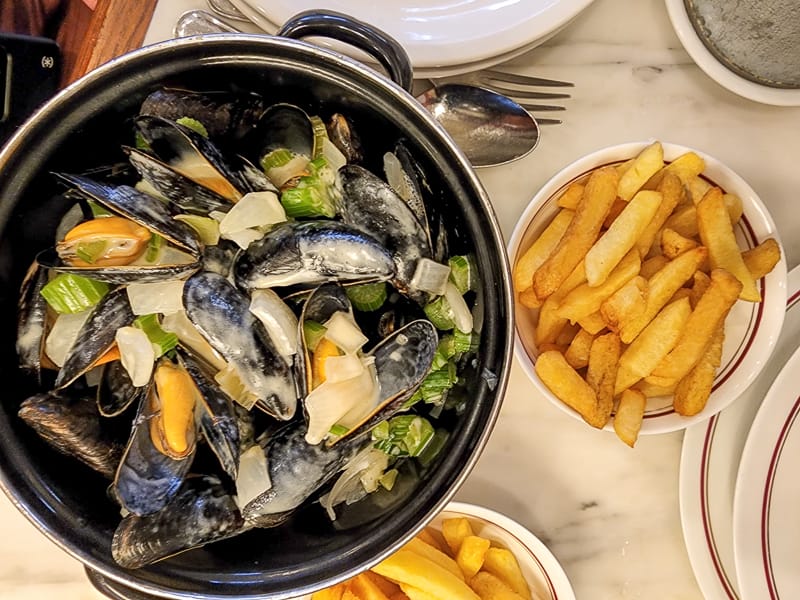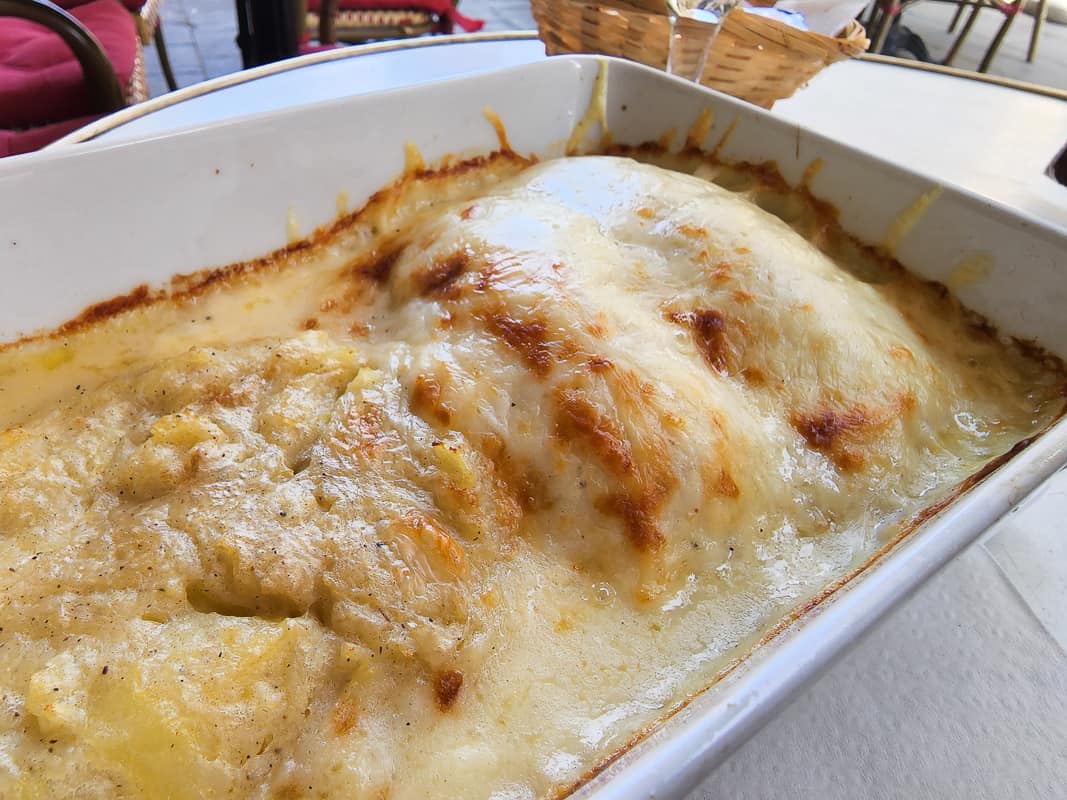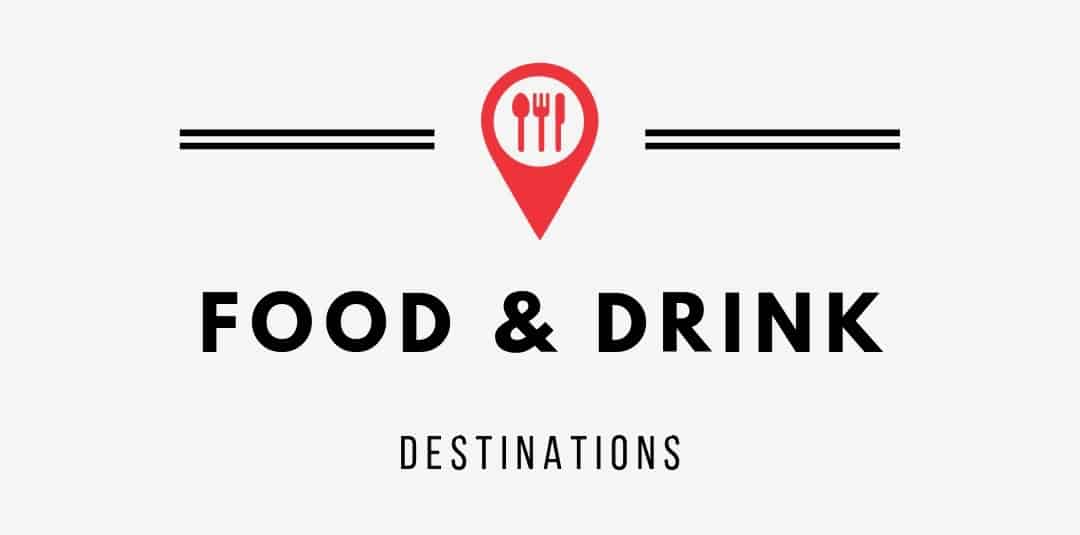Belgium isn’t always talked about in terms of great places in the world to visit for its cuisine. However, Belgian food is hugely underrated. Belgium and Brussels food, in particular, is more than chocolate, mussels, and frites. Here’s a look at 17 things to eat in Brussels spanning a wide range of Belgian cuisine.
*This post contains compensated links. Find more info in my DISCLAIMER. As an Amazon Associate, I earn from qualifying purchases.
What To Eat In Brussels

One of the most important things to know about Brussels is there’s food everywhere. Brussels is known to the world for its murals, statues, and monuments, as well as the famous Belgium chocolate everyone knows and loves.
Because of the country’s close proximity to France, famed for its culinary culture, sometimes Belgium gets forgotten about, or at least when it comes to the food, when in fact, there is a lot to be said for Belgian food in Brussels.
In recent years, the culinary scene in Brussels has been making more of a statement, and we are seeing more and more remarkable places to eat pop up.
There is even now a large selection of Michelin-star restaurants in Brussels, such as Bon Bon, Bozar, and Le Chalet de la Foret.
If you’re visiting Belgium with the intention of trying all the food you can, this guide will be a great thing to keep on hand during your trip.
Another good way to ensure you’re trying all the locally recommended foods is to take part in one of the food tours in Brussels. They have loads on offer for various prices.
Let’s take a look at the 17 must-try foods in Brussels, Belgium.
Moules Frites – Belgian Mussels

You can eat mussels no matter where you are in the world, but there is something special about the Moules Frites you get when eating in Brussels, Belgium.
A piping hot bowl of fresh mussels on the side of a generous portion of chunky fries is a food in Brussels that you must seek, not that you’ll have to look far.
In most restaurants in Brussels, Belgium, you’ll find that they serve the Moules Frites like a mariniere sauce. This is a sauce made with white wine, cream, and fresh parsley. For Amber and me, there’s no other way to eat them.
If you’re wondering where to try Moules Frites or any other form of seafood in Brussels, I recommend heading to Aux Armes de Bruxelles. This is one of the most restaurants in Brussels, Belgium. It dates back to the 1920s and is such a treat.
Frites – Belgium Fries

No matter who you are or where you’re from, you’ve eaten fries at some point in your life, right? One thing that people seem to argue about is where fries begin.
Is France, or was the humble fish and chips from Britain, where it all began? Well, no matter where fries started, one sure thing is that they’ve become a staple side dish to most meals.
The fries in Brussels, Belgium stand out slightly from anywhere in the world, mainly because they come with a tremendous selection of sauce accompaniments.
Some food stalls offer up to 30 different sauces for one portion of fries. Our favorite place for frites in Brussels was the perfectly named Fritland. They were perfectly cooked and came with a ton of choices for sauce.
Pro Tip: If you love frites in Brussels, make sure to treat yourself to steak frites. And don’t forget to enjoy the steak frites with a proper pint of Belgian beer.
Mitraillette

Amber and I both attended Rutgers University for undergrad. At Rutgers, we had the “Fat Cat” sandwich. A delicious sandwich featuring two cheeseburgers, fries, lettuce, and tomato.
After graduating, I thought we’d never get to enjoy a Fat Cat-type sandwich again. That is until we got to Brussels and ate a “mitraillette”.
The mitraillette is a sandwich that you’ll see in many cafes and restaurants in Brussels. It’s a popular grab-and-go food, as it’s easy to eat on the move and cheap to buy.
Mitrailletes were originally only served with sausage. It has been adapted, and now the sandwich is filled with two beef burgers placed side-by-side. It is also loaded with fries, much like my beloved “Fat Cat”.
In true Belgian style, you get to choose from a wide range of sauces such as bearnaise, mayonnaise, or ketchup. Some places also offer a choice of salad items like cabbage and carrot.
All of these tasty ingredients are stuffed inside a fresh, crunchy baguette. To try the best mitraillete in Brussels, head over to our favorite place, Fritland.
Stoemp – Mashed Potato

Mashed potatoes, or Stoemp, are a big deal when it comes to food in Brussels. It differs slightly from the mashed potatoes you might make at home to go with your sausage and gravy.
Stoemp is usually mashed potatoes mixed with another ingredient, such as carrots, leeks, peas, onions, or cabbage.
More often than not, the stoemp is also flavored with dry or fresh herbs like thyme and bay leaves. You can have stoemp on the side of any main course. but for typical Belgium foods, you’re likely to get it on the side of braadworst, boudin, or bacon, and occasionally with fried eggs.
Belgium Waffles and Brussels Waffles

You might be surprised to hear that there are, in fact, two different kinds of waffles in Brussels. No matter where you visit in Belgium, one thing you’ll be keen to try first is the waffles.
Is there a more famous Belgian food? This was certainly the case with us and Amber insisting we eat waffles as soon as we arrive.
Most cafes in Brussels will have both kinds of waffles on the menu, so you can take your pick of the two or try both if it’s your first time.
The waffles in Brussels are made using a yeast-leavened batter. This makes them much lighter and fluffier in texture.
They are usually rectangular in shape and have deeper crevices which means they can be filled with even more sugary goodness.
Other waffles in Belgium are made using a much thicker batter, which means they are dense in consistency. They are also not a specific, perfect shape; they’re instead much more rustic looking.
This kind of waffle has sugar mixed into the batter, so once cooked, it creates a beautifully caramelized crust on the outer parts. Make sure you add some ice cream and a big helping of whipped cream on top.
We ate our Brussels waffles at Maison Dandoy – Galeries. A cute cafe serving waffles, coffee, and other desserts with locations around the city.
Belgian Beer

Ok, I’m well aware that Belgian beer isn’t food. But how could we write about Brussels or Belgian food without talking a little about Belgian beer?
After all, Belgian beer might be more famous than Belgian chocolates, mussels and frites, and Belgian waffles combined. And to be fair, Belgian beer is so complex with a long history it deserves its own post. Stay tuned.
For the record, I’m not the biggest fan of most Belgian beers. With the exception of lambics. Sorry, they simply don’t suit my palate.
During our week in Brussels, we visited a ton of bars as well as a couple of breweries. Regardless of how I feel about Belgian beers, here are a few places worth checking out: Cantillon Brewery, Moeder Lambic Fontainas, and Delirium.
Balletjes – Belgian meatballs

Balletjes are bite-size meatballs made using a combination of ground beef and pork so that the beef can add a depth of flavor, while the pork provides the fatty element needed to hold the balls together.
The tiny meatballs are usually cooked in a tasty soup, often vegetable, but it can be anything, and off the top of my head, I can’t think of a single soup that wouldn’t benefit from the addition of juicy meatballs.
This is a traditional Belgian food that is often enjoyed at family-meal times.
If you ask any locals, they will likely be able to reminisce about sitting around their grandparents’ dinner table while their Grandma cooked a pan of soep met balletjes.
We tried the balletjes at Le Falstaff, a historic restaurant just around the corner from the Grand Palace.
Vol-au-vent
Have you ever been to a family buffet and party and filled your plate with different flavored vol-au-vents? Okay, maybe back in the 80s, but have you ever wondered where they come from? Well, the answer is Brussels.
If you’re not sure what a vol-au-vent is, it’s a small, hollow, flaky pastry that is filled with various things. They can be either sweet or savory, and some flavors include creamed mushrooms, shredded meat, shrimp, or jam.
Carbonnade Flamande – Flemish Beef Stew
Carbonade Flamande is a Belgium/Flemish beef and ale stew. The stew is cooked in a rich, velvety gravy, which is what makes it such a popular comfort food in homes in and around Brussels, as well as in other parts of Belgium, France, and the Netherlands.
Carbonade is a French name for a thick stew or slow-cooked beef and beer with herbs and onions. It is thought that this dish originated in the East of France in a district called French Flanders.
What gives this dish its intense, unique flavor, aside from the beer and beef, is the caramelized onions. The most popular way to serve this stew is with spiced or gingerbread, mustard, and fresh herbs.
Belgium Endive – Chicons Au Gratin

Endive is a type of lettuce, quite a bit thicker than salad lettuce. It has a crunchy, juicy core and is excellent for cooking due to its bitter flavor and tightly packed leaves.
This is a typical Belgium food that is usually found braised, baked, or grilled in many restaurants, and it’s served as a healthy accompaniment to any meat or potato-based Belgium foods.
Though somewhat bitter in taste in its raw state, it develops a sweet, almost nutty flavor when cooked.
Amber decided to make this a lunch one afternoon at Le Falstaff.
Gray Shrimp

During shrimp season in Belgium, Grijze Garnalen is a traditional Belgian food that is considered something of a refined dish in many high-end restaurants in Brussels.
Gray shrimp dishes can also be enjoyed at many cafes and Belgian street food markets across the country.
As well as being enjoyed as a fancy appetizer, they also make an excellent accompaniment to a good Belgian beer. There are many shrimp-based dishes to look out for during shrimp season, such as shrimp croquettes and tomate-crevettes.
I have to admit I was looking forward to trying gray shrimp. Unfortunately, they weren’t really to my liking but definitely worth tasting.
Rabbit – Lapin a la Kriek
After living in Catalonia for three years, Amber and I can’t get enough rabbit. Catalan food features a ton of rabbit. It’s light, it’s flavorful and so versatile. Learning that rabbit features in Belgian cooking, we were very excited to taste Lapin a la Kriek.
Lapin a la Kriek is another rich, gravy-based dish, made with rabbit meat.
The sauce, like Carbonade Flamande, is made with beer but with the extra addition of cherries to compliment the gamey flavors of the rabbit. It was everything we were hoping for and more. Definitely make sure you try this dish.
Frogs Legs

France probably springs to mind when you see the words frogs legs. However, the consumption of frog legs is also prevalent in Belgium.
And that’s music to our ears. Much like rabbit, Amber and I can’t get enough frog legs. Ever since our first trip to SE Asia, we’ve been hooked on them.
Frog legs are a traditional delicacy in Brussels. If you’re ordering them in a restaurant, they will usually be served in a simple dressing made with cream, butter, garlic, chervil, parsley, and plenty of salt and pepper.
We highly recommend the frog legs at Aux Armes de Bruxelles. Order them alongside some mussels and frites as we did.
White Asparagus
You may only have ever enjoyed asparagus of the standard green kind. However, in Brussels, you will find that many of the asparagus dishes use the white variety.
The color comes from the way the asparagus is grown. The white color comes from a lack of light during the growing process.
Another difference, aside from the color, is the thickness and the fact it is much more fibrous. White asparagus is commonly served as a side dish in Belgian restaurants with a hollandaise sauce or a simple olive oil dressing.
Pro Tip: White asparagus is harvested between April and June so plan your trip accordingly.
Belgian Chocolate

You would be right in thinking that you can’t escape Belgian chocolate while visiting Brussels. After all, it’s probably what they’re most famous for and next to Swiss.
Belgian chocolates are considered to be one of the best chocolates in the world. And as somebody who doesn’t eat a lot of chocolate, they are outstanding.
Like their beer making, Belgian chocolatiers put a lot of dedication and passion into their chocolate making.
If you’re wondering where to find the best chocolate shops and get the most out of your experience, we recommend opting for one of the Belgian chocolate tours.
If you are short on time and don’t want to do a tour, don’t worry. There are TONS of chocolate shops around Brussels. NEUHAUS Brussels Galerie De La Reine is a good place for chocolate and has super knowledgeable staff.
Cuberdons

While we’re on the subject of Belgian sweet treats, let’s talk about cuberdons. A popular delicacy in Brussels as well as throughout much of Belgian. Cuberdons are a local food not to be missed.
These cone-shaped delights are made using gum Arabic candy and are filled with a sticky raspberry-flavored substance.
They are purple-colored and shaped like a cone or nose, hence the nickname “neuzeke,” which translates to “little nose.”
Pate en Croute

Pate en Croute is not as simple as pate on toast. Which is what you’re probably getting from its title. Instead, it’s actually closer to a meat pie.
Recipes vary, but it’s typically ground pork shoulder and veal. Some restaurants have adapted the recipe to include meats such as chicken, rabbit, and diced pancetta.
The heavily marinated meat is then wrapped in a flakey pastry. The pie is usually served at room temperature with a fresh green salad, and it’s recommended to enjoy an ice-cold glass of white wine to complement it.
During our trip to Brussels, we ate at a couple of Michelin Star restaurants including Bozar. Bozar is one of the many One Michelin Star restaurants in Brussels. It’s also famous for its Pate en Croute.
Mushroom Toast
Mushroom toast is a popular appetizer in Brussels, as it is in many Western and European countries.
The concept is simple and comprises mushrooms with either creamed cheese sauce or cooked in garlic butter and oil, with a handful of fresh herbs and plenty of black pepper.
The type of mushrooms used can depend on the seasons, but wild mushrooms or diced portobello mushrooms are commonly used in Brussels.
FAQs – Things To Eat In Brussels
It should be what food isn’t Brussels famous for. Easily the three most famous foods to eat in Brussels are chocolate, mussels, and frites (French fries). For more adventurous eaters, Brussels is also famous for rabbit and frog legs.
You are not going to find an American-style breakfast with eggs and bacon in Brussels. Or at least that’s not what the Belgians eat for breakfast. Most Belgians eat a breakfast consisting of bread or croissant, jams, ham, and cheese. Coffee, tea, and juice are the most common breakfast drinks.
Not all waffles are created the same. Compared to “regular” or American-style waffles, Belgian waffles are thicker and sweeter. Additionally, Belgian waffles are usually enjoyed as a snack with whipped cream. Whereas American waffles are eaten for breakfast and served with maple syrup.
